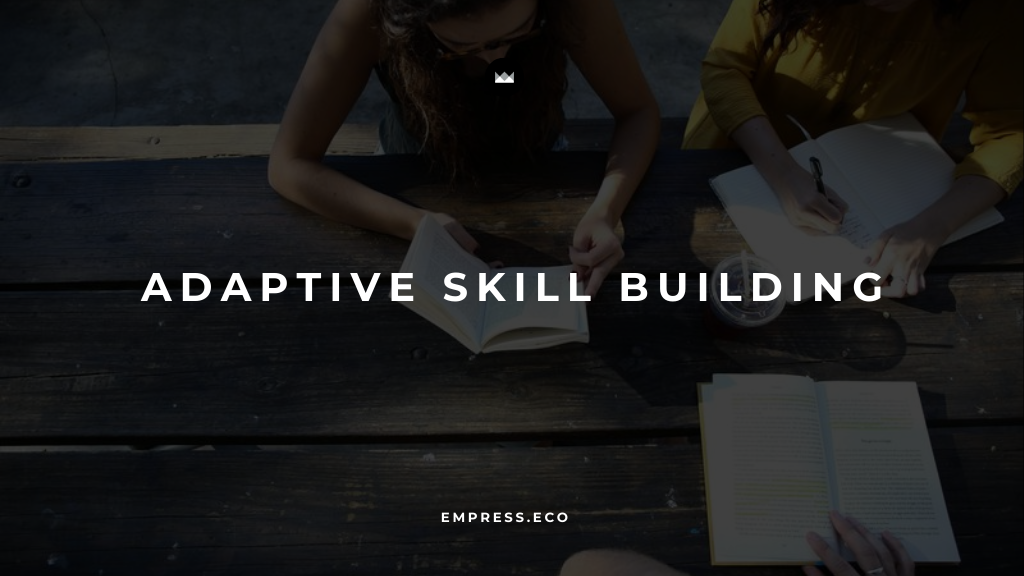
Future-Proofing Your Workforce with Adaptive Skill Development
Keep your workforce ready for tomorrow’s challenges with adaptive skill development.
Table of Contents
In a world where technology evolves at a breakneck pace and market conditions can change in the blink of an eye, the ability to adapt has become a key determinant of success. Organizations that fail to keep up with these changes risk falling behind their competitors, while those that proactively prepare their workforce for the future stand to gain a significant advantage. This is where Adaptive Skill Development comes in—a forward-thinking approach to training that ensures your employees are always equipped with the skills they need to thrive in a constantly evolving environment.
In this blog, we’ll explore the concept of Adaptive Skill Development, its benefits, and how you can implement it within your organization to future-proof your workforce.
Understanding Adaptive Skill Development
Adaptive Skill Development is more than just a buzzword; it’s a strategic approach to workforce training that focuses on keeping employees’ skills up-to-date with the latest industry trends and technological advancements. Unlike traditional training methods that may become outdated quickly, Adaptive Skill Development is designed to be flexible, responsive, and continuously evolving.
This approach involves regularly assessing the current skills and competencies of your workforce, identifying gaps, and providing targeted training programs that address these gaps. It’s about being proactive rather than reactive—anticipating future challenges and opportunities, and preparing your employees to meet them head-on.
Imagine your workforce as a fleet of ships navigating a constantly shifting ocean. Traditional training might provide them with a static map, useful for a while but eventually outdated as the landscape changes. Adaptive Skill Development, on the other hand, equips your fleet with real-time navigation tools, allowing them to adjust course as needed and stay on the right path, no matter what the future holds.
Key Benefits of Adaptive Skill Development
So, why should you invest in Adaptive Skill Development? Let’s explore some of the key benefits:
1. Relevance and Agility
In a rapidly changing world, the skills that were relevant yesterday might not be sufficient tomorrow. Adaptive Skill Development ensures that your employees’ skills are always aligned with the latest industry trends and technologies, making them more agile and capable of responding to new challenges with confidence.
For example, consider a tech company that regularly updates its software development tools. By implementing Adaptive Skill Development, the company ensures that its developers are always trained on the latest tools and methodologies, allowing them to maintain high productivity and deliver cutting-edge solutions.
2. Increased Innovation
A workforce that is constantly learning and adapting is more likely to drive innovation. When employees are equipped with up-to-date skills, they are better positioned to contribute fresh ideas and new approaches that can enhance organizational performance and competitiveness.
For instance, a marketing team that stays current with the latest digital marketing trends and technologies is more likely to experiment with innovative strategies that can set the company apart from its competitors.
3. Enhanced Employee Engagement
Employees want to grow, learn, and advance in their careers. By providing them with continuous opportunities for skill development, you foster a sense of purpose and motivation that leads to higher engagement and job satisfaction.
When employees see that their organization is committed to their professional growth, they are more likely to feel valued and engaged, which in turn reduces turnover and boosts overall productivity.
4. Improved Talent Retention
One of the key drivers of employee retention is the availability of growth opportunities. Adaptive Skill Development demonstrates your organization’s commitment to helping employees grow and succeed, which can significantly increase retention rates and reduce the costs associated with turnover.
For example, an employee who regularly receives training and development opportunities is less likely to seek career advancement elsewhere, knowing that they can achieve their goals within the organization.
5. Future-Ready Workforce
Perhaps the most significant benefit of Adaptive Skill Development is that it prepares your workforce for the future. By proactively developing the skills that your employees will need to meet tomorrow’s challenges, you ensure that your organization remains resilient, adaptable, and ready to seize new opportunities as they arise.
This future-proofing is especially important in industries that are subject to rapid technological change, such as finance, healthcare, and technology. By staying ahead of the curve, your organization can maintain its competitive edge and continue to thrive in a dynamic marketplace.
Implementing Adaptive Skill Development
Now that we’ve covered the benefits of Adaptive Skill Development, let’s look at how you can implement it effectively within your organization. Here are some key strategies to consider:
1. Conduct Regular Skills Assessments
The first step in implementing Adaptive Skill Development is to understand the current skill levels and competencies within your organization. This involves conducting regular skills assessments to identify gaps and areas for development.
These assessments can take various forms, such as employee surveys, performance reviews, and skills audits. The goal is to gather data on the current capabilities of your workforce and identify where additional training is needed.
For example, if your company is planning to adopt a new technology platform, you might assess the technical skills of your IT team to determine whether they need additional training to effectively implement and manage the new system.
2. Stay Informed on Industry Trends
To ensure that your training programs remain relevant and forward-looking, it’s essential to stay informed about the latest industry developments and technological advancements. This means regularly monitoring industry news, attending conferences, and engaging with thought leaders in your field.
By keeping a finger on the pulse of your industry, you can anticipate emerging trends and adjust your training programs accordingly. This proactive approach ensures that your employees are always prepared to tackle new challenges and take advantage of new opportunities.
For instance, if you notice a growing trend towards automation in your industry, you might begin offering training programs that focus on developing skills in robotic process automation (RPA) and artificial intelligence (AI).
3. Design Flexible Training Programs
Adaptive Skill Development requires training programs that are flexible and can be easily adapted to changing needs and priorities. This means designing programs that offer a mix of learning formats, such as online courses, workshops, and experiential learning, to cater to different learning preferences.
Flexibility also means being able to quickly update and modify training content as new trends and technologies emerge. For example, if a new software tool becomes widely adopted in your industry, you should be able to integrate training on that tool into your existing programs without delay.
Additionally, consider implementing modular training programs that allow employees to learn at their own pace and focus on the areas that are most relevant to their roles. This approach not only makes training more accessible but also ensures that employees are learning the skills they need most.
4. Leverage Technology for Learning
Technology is a key enabler of Adaptive Skill Development. By utilizing digital platforms and tools, you can deliver training content efficiently and at scale, ensuring that all employees have access to the resources they need to stay current.
Learning Management Systems (LMS), online learning platforms, and mobile learning apps are all valuable tools for delivering adaptive training programs. These platforms allow you to create personalized learning paths, track employee progress, and provide real-time feedback.
For example, an LMS can automatically recommend training modules based on an employee’s current skill level and career goals, making it easier for them to stay on track with their development.
5. Foster a Culture of Lifelong Learning
Adaptive Skill Development is most effective when it’s supported by a culture that values lifelong learning. This means creating an environment where continuous learning is encouraged, supported, and recognized as a key component of career success.
To foster this culture, consider offering incentives for employees who actively pursue learning opportunities, such as recognition programs, rewards, or even career advancement opportunities. Additionally, ensure that managers and leaders are actively involved in promoting and supporting continuous learning within their teams.
For example, you might establish a “Learning Ambassador” program where employees who demonstrate a strong commitment to learning are given special recognition and opportunities to mentor others in the organization.
Challenges and Considerations
While Adaptive Skill Development offers numerous benefits, it’s important to be aware of potential challenges and considerations:
1. Resource Allocation
Implementing adaptive training programs requires a significant investment of time, effort, and resources. Organizations must carefully prioritize these investments based on strategic goals and workforce needs.
For example, you might need to allocate budget for new training materials, invest in an LMS, or hire additional staff to support learning and development efforts. It’s important to ensure that these investments are aligned with the overall goals of the organization and provide a clear return on investment.
2. Balancing Work and Learning
One of the challenges of Adaptive Skill Development is ensuring that employees can balance their workload with learning activities. Overloading employees with too much training can lead to burnout and decreased productivity.
To address this challenge, consider offering flexible learning options that allow employees to engage in training at their own pace. You might also work with managers to ensure that learning activities are integrated into the workday in a way that doesn’t disrupt regular responsibilities.
For instance, you might set aside specific times during the week for learning activities or offer shorter, micro-learning sessions that employees can complete during breaks or downtime.
3. Measuring Impact
Evaluating the effectiveness of adaptive skill development initiatives can be complex. It’s important to establish clear metrics and goals from the outset to assess success and make informed improvements.
Consider using a combination of qualitative and quantitative measures to evaluate the impact of your training programs. For example, you might track changes in employee performance, productivity, and job satisfaction before and after implementing adaptive training programs. Additionally, gathering feedback from employees on the relevance and usefulness of the training can provide valuable insights into areas for improvement.
Conclusion
Future-proofing your workforce with Adaptive Skill Development is a strategic approach to ensuring organizational resilience and success. By continuously updating training programs to reflect the latest industry trends and technologies, companies can keep their employees agile, engaged, and prepared for the future.
As the pace of change accelerates, embracing adaptive skill development will be essential for maintaining a competitive edge and achieving long-term success. At Sage, we are committed to helping our clients create dynamic learning environments that empower their teams and drive organizational excellence.
Are you ready to prepare your workforce for the future? Let’s work together to create a customized Adaptive Skill Development program that keeps your employees at the cutting edge of their field and supports your organization’s growth.
Empress Newsletter
Join the newsletter to receive the latest updates in your inbox.



